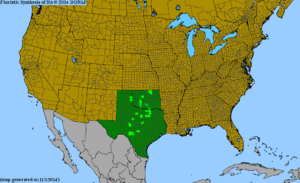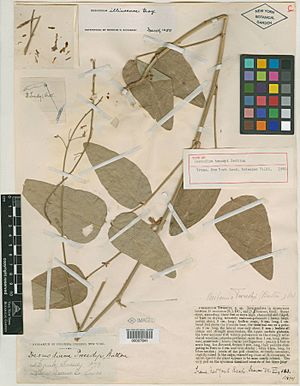Desmodium tweedyi facts for kids
Quick facts for kids Desmodium tweedyi |
|
|---|---|
| Scientific classification | |
| Genus: |
Desmodium
|
| Species: |
tweedyi
|
 |
|
| Distribution map created by Biota of North America Program (BONAP), J.T. Kartesz | |
Desmodium tweedyi is a type of herbaceous flowering plant that belongs to the pea family. It grows naturally in northern Texas and southern Oklahoma. People often call it "Tweedy's ticktrefoil" or "tick-clover." These names come from its seed pods, which are shaped like tiny chains and can easily stick to clothing, just like ticks!
Like other plants in the Desmodium genus, D. tweedyi is useful for many things. It can help make soil richer, keep harmful insects away, and provide good food for animals like deer, turkeys, and cattle.
Contents
About Tweedy's Ticktrefoil
What's in a Name?
The scientific name for this plant is Desmodium tweedyi Britton.
- Desmodium comes from the Greek word desmos, meaning "bond" or "chain." This describes the plant's fruit, which looks like connected segments in a chain.
- Tweedyi is named after Frank Tweedy, a topographer and botanist. He was the first person to collect a sample of this plant.
- "Britton" refers to Nathaniel Lord Britton, the botanist who first officially identified and named the species.
How Scientists Classify Plants
Scientists use a system called taxonomy to organize and group all living things, including plants. This helps them understand how different species are related. For Desmodium tweedyi, the classification goes like this:
- Kingdom: Plantae (All plants on Earth)
- Clade: Tracheophytes (Plants with special tubes to carry water and nutrients)
- Clade: Angiosperms (Plants that produce flowers)
- Clade: Eudicots (Flowering plants that start with two seed leaves)
- Clade: Rosids (A large group of flowering plants)
- Clade: Fabids (An important group that includes plants able to "fix" nitrogen from the air, which helps enrich the soil)
- Order: Fabales (A group of flowering plants often found in warm places, known for their many flowers and seed pods)
- Family: Fabaceae (The pea family, the third largest family of flowering plants. It includes many important food sources like beans and peas. They are known for their special ability to fix nitrogen in their roots.)
- Subfamily: Faboideae (A large group within the pea family, including trees, shrubs, and herbaceous plants like D. tweedyi. Many in this group also have nitrogen-fixing roots.)
- Tribe: Desmodieae (A smaller group within the Faboideae subfamily)
- Genus: Desmodium (This genus has about 450 species, mostly found in warm parts of the world. Their fruit segments stick to hair or clothing, earning them nicknames like "Tick-clover" or "Beggar's-ticks.")
- Species: Desmodium tweedyi (Our specific plant!)
D. tweedyi has many of the special features of its "parent" groups, especially the ability to fix nitrogen, which makes it valuable for farming and conservation.
What the Plant Looks Like
Desmodium tweedyi can grow up to four feet tall.
- Leaves: Its leaves are 1 to 4.5 inches wide, often egg-shaped, and covered with soft, straight hairs. They have raised veins and a distinct pale or whitish area along the middle vein (Picture D). The leaves usually grow in groups of three.
- Flowers: The flowers are white, sometimes with a greenish or yellowish tint, and may have a lavender base (Picture A). They grow in clusters on a stalk (Picture B).
- Fruit: The fruit is a pod (called a legume) that breaks into two to six flat segments, each about 0.2 to 0.3 inches long. These segments have tiny hooked hairs that make them stick to things, like clothing or animal fur. This chain-like pod is a key feature of the Desmodium genus (Picture C).
Where Tweedy's Ticktrefoil Grows
Desmodium tweedyi prefers to grow in thickets in limestone areas. You can find it in central Texas, from the Blackland Prairie to the Edwards Plateau. It likes sandy soil near creeks and rivers. The plant usually flowers and produces fruit from early June to July.
Geographical Distribution
This plant species is mainly found in north-central Texas and southern Oklahoma. While some reports questioned its presence in Oklahoma, many collected samples confirm it grows there too. The map at the top of this article shows its distribution in Texas and Oklahoma.
The plant was named after Frank Tweedy (1854-1937), a topographer for the United States Geological Survey and a dedicated botanist. He collected over 6,000 plant samples, which are now stored in special collections called herbaria across the US and Canada. Tweedy collected Desmodium tweedyi in Tom Green County, Texas, which is right in the middle of where this plant grows.
Research and Uses
How the Species Was Discovered
Nathaniel Lord Britton, a botanist from the New York Botanical Garden, officially described Desmodium tweedyi. Frank Tweedy sent his collected sample to Britton, who realized it was a new species and named it in Tweedy's honor. This scientific name has remained valid, even though there has been some confusion with other similar species over the years.
Agricultural Interest
In recent years, Desmodium tweedyi has become interesting to farmers and researchers.
- Soil Improvement: Studies have shown it can help improve soil fertility and add nitrogen to the soil.
- Animal Food: It's also being considered for use in "deer plots" and pastures for animals like goats and cattle. It provides good protein for these animals.
- Restoration: Because it's a native plant, it's useful for restoring natural prairies and woodlands, helping to bring back biodiversity.
The Legume Family Tree
Scientists are constantly researching the Fabaceae (legume) family, to which D. tweedyi belongs. They are trying to understand how this diverse family evolved.
- Most legumes, including D. tweedyi, are thought to have come from a common ancestor about 50 million years ago.
- The ability of some legumes to "fix" nitrogen (take nitrogen from the air and turn it into a form plants can use) is a special trait. D. tweedyi has this important ability.
Protecting the Plant
Scientists have looked at the conservation status of Desmodium tweedyi globally, nationally (in the US), and specifically in Texas.
- Global Status: It's considered "Vulnerable" because its range is fairly small, and there aren't many populations. This means it's at a moderate risk of disappearing.
- US and Texas Status: It's also ranked "Vulnerable" in the US and Texas for similar reasons.
Since Desmodium tweedyi only grows in a small area of Texas and Oklahoma, conservation efforts are important to protect it. Its use in agriculture could also help spread it to a wider area, which would benefit the species.


